
One Ninety One Peachtree Tower is a 235 m (771 ft) 50-story skyscraper in Atlanta, Georgia. Designed by Johnson/Burgee Architects and Kendall/Heaton Associates Inc, the building was completed in 1990 and is the fourth tallest in the city, winning the BOMA Building of the Year Awards the next year, repeating in 1998 and 2003.

The architecture of Atlanta is marked by a confluence of classical, modernist, post-modernist, and contemporary architectural styles. Due to the complete destruction of Atlanta by fire in 1864, the city's architecture retains no traces of its Antebellum past. Instead, Atlanta's status as a largely post-modern American city is reflected in its architecture, as the city has often been the earliest, if not the first, to showcase new architectural concepts. However, Atlanta's embrace of modernism has translated into an ambivalence toward architectural preservation, resulting in the destruction of architectural masterpieces, including the Commercial-style Equitable Building, the Beaux-Arts style Terminal Station, and the Classical Carnegie Library. The city's cultural icon, the Neo-Moorish Fox Theatre, would have met the same fate had it not been for a grassroots effort to save it in the mid-1970s.

1180 Peachtree, commonly known as the Symphony Tower, is a 41-story skyscraper located at 1180 Peachtree Street in the Midtown district of Atlanta, Georgia, United States. Rising to a height of approximately 657 feet (200 m), the building includes office and retail space in its 624,996 sq ft (58,064 m2) of floor area as well as a 1,200 space parking deck. Construction was completed in 2006.
The Kimball House was the name of two historical hotels in Atlanta, Georgia. United States. Both were constructed on an entire city block at the south-southeast corner of Five Points, bounded by Whitehall Street, Decatur Street, Pryor Street, and Wall Street, a block now occupied by a multi-story parking garage.

Peachtree Center is a district located in Downtown Atlanta, Georgia. Most of the structures that make up the district were designed by Atlanta architect John C. Portman, Jr. A defining feature of the Peachtree Center is a network of enclosed pedestrian sky bridges suspended above the street-level, which have garnered criticism for discouraging pedestrian street life. The district is served by the Peachtree Center MARTA station, providing access to rapid transit.

The Hotel District is a neighborhood in Downtown Atlanta, Georgia, United States. The district's name is derived from it being the home to many hotels, one of them being the famous Westin Peachtree Plaza Hotel. The Hotel District is generally considered to be bounded by the Downtown Connector to the east, Five Points to the south, Centennial Olympic Park to the west, and Midtown to the north. The district's primary thoroughfare is Peachtree Street, which contains most of the restaurants, hotels, and office buildings. The intersection of Andrew Young International Boulevard and Peachtree Street forms the heart of the district.
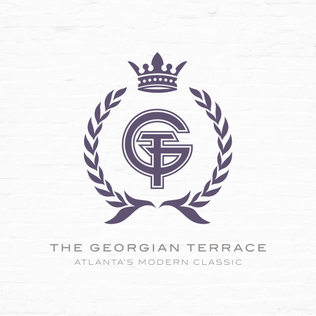
The Georgian Terrace Hotel in Midtown Atlanta, part of the Fox Theatre Historic District, was designed by architect William Lee Stoddart in a Beaux-Arts style that was intended to evoke the architecture of Paris. Construction commenced on July 21, 1910, and ended on September 8, 1911, and the hotel opened on October 2, 1911. The George C. Fuller Construction Company was contractor, and the developer was Joseph F. Gatins, Jr.
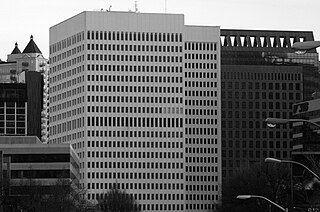
Colony Square is a mixed-use development and sub-district in Midtown Atlanta, Georgia, located on Peachtree Street in between 14th and 15th Streets. The oldest high-rise development in Midtown, the sub-district was built between 1969 and 1975, with Henri Jova of Jova/Daniels/Busby serving as principal architect. It was the first mixed-use development in the Southeast.

Walter T. Downing (1865-1918) was an American architect in Atlanta, Georgia. Several of his works are listed on the National Register of Historic Places.
The Norcross Building occupied the southwest corner of Peachtree Street and Marietta Street at Five Points in downtown Atlanta. Today the Andrew Young School of Policy Studies is located on the site. The building was owned by Jonathan Norcross, "father of Atlanta."
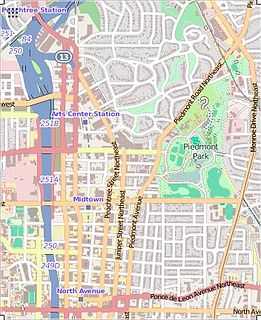
The Atlanta Cabana Motel was a 200-room motor hotel located at the southwest corner of Peachtree Street and 7th Street in Midtown Atlanta. It opened in 1958 and was razed in 2002; the site is now occupied by the 28-floor Spire residential tower. The Cabana was Atlanta's first major new hotel in 30 years as well as a pioneer in the concept of motor hotels, that is, motel-like facilities in cities, as opposed to alongside highways between cities. It was recognized as a prime example of modern motor hotel architecture.

The Majestic Hotel was built in 1898 and located at 195 Peachtree Street NW in Atlanta, between Ellis St. and Cain St.. It was a major addition to the city's hotel capacity at its completion in the 1890s. It cost between $80,000 and $100,000 to build, and was the first brick and steel fireproof construction in the city. A 1902 guidebook describes the Majestic as one of three chief first-class hotels in the city, together with the Kimball House and the Hotel Aragon. In 1927 the hotel was razed to make way for a two-story commercial structure. The site is part of the location of today's 191 Peachtree Tower.

Francis Palmer Smith was an architect active in Atlanta and elsewhere in the Southeastern United States. He was the director of the Georgia Tech College of Architecture from 1909–1922.
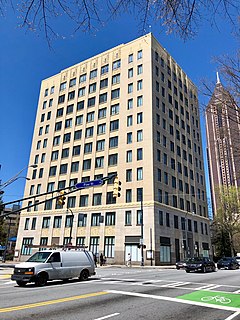
The W. W. Orr Building is an 11-story landmark building at 478 Peachtree Street NE in SoNo, Atlanta.

The William–Oliver Building is a 1930 Art Deco landmark building at 32 Peachtree Street NW at Five Points, Downtown Atlanta. It currently consists of 115 apartments. Its architect was Francis Palmer Smith of Pringle and Smith and was Atlanta's first completed Art Deco skyscraper. It was named after developer Thomas G. Healey's grandsons William and Oliver.

The Paramount Theater was a theater that stood from 1920 to 1960 on Peachtree Street between Ellis and Houston streets in downtown Atlanta, next to Loew's Grand Theatre. It was designed by architectural firm Hentz, Reid & Adler. Upon its opening, the Atlanta Constitution called it "the South's most palatial theater", and had a pipe organ and seating for 1,000 people. Enrico Leide, conductor of the first Atlanta Symphony Orchestra, was chosen as music director.

The Connally Building is located at 54 Peachtree Street in Downtown Atlanta, adjacent to the Underground Atlanta retail center. It is a work of architect William Lee Stoddart, completed in 1916. The building has been so extensively renovated that it bears little resemblance to the original design, other than the terra cotta façade on the lower stories. This was originally a six-story office building with a terracotta facade, which replaced an earlier Connally Building on the site. In 1990, eleven stories were added and it was converted into a hotel. It has operated under the names Howard Johnson Plaza Suites, University Place at Underground, The Suite Hotel at the Underground, and most recently it became a Fairfield Inn & Suites.

Hotel Indigo Atlanta Midtown is a historic building in midtown Atlanta, Georgia. Designed by Atlanta-based architectural firm Pringle and Smith in 1925, the brick building is located on Peachtree Street, across from the Fox Theatre.
Alexander F. N. Everett, also known as A. F. N. Everett, was an American architect who designed many buildings in his hometown of Atlanta, Georgia, including some listed on the National Register of Historic Places.
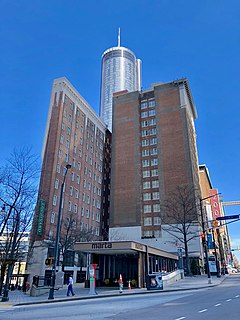
This article is about hotels in Atlanta, including a brief history of hotels in the city and a list of some notable hotels.

















